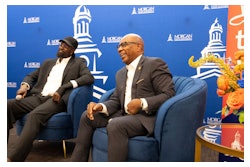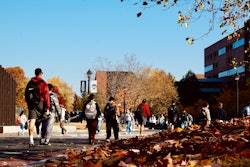Declining graduate school admissions rates for international students have long-term implications on American institutions of higher learning and the stability and competitiveness of the U.S. economy and work force, according to a report released Thursday by the Council of Graduate Schools (CGS).
The organization’s 2008 International Graduate Admissions Survey, “Phase II: Final Applications and Initial Offers of Admission,” found that while offers of admission increased 4 percent from 2007 to 2008, the overall rate of increase in admission offers from U.S. graduate schools to prospective international students declined by 8 percent in 2007.
“There’s a lot of interest out there, but the level of interest tends to be waning a little bit,” says Kenneth E. Redd, the report’s author and director of research and policy analysis for CGS.
The rate of increase for admissions offered to students from India dropped; there was a 10 percent increase in 2007 compared to a 2 percent increase this year, according to the report. It also found the overall slowdown in application growth is apparent in students from China.
The survey findings also indicate that every field saw a slowdown in the final rate of growth of applications, with the most pronounced slowdowns in life sciences and education.
Because international students tend to take up disciplines in mathematics, physical sciences and engineering, Redd says, graduate schools need to implement more programs to retain and increase the numbers of these students in the U.S. work force. If not, he says, it could mean that the United States will not be able to fill these positions in the future and will lose its competitiveness in the global economy of the 21st century.
“U.S. citizens tend [to] focus on education, business and health care,” Redd says.
An expert on student financing and higher education, Redd says the report acts as a tool by which the United States can gauge its ability to engage in international partnerships on an educational level. He adds that many institutions were concerned with attracting international students after the Sept. 11 terrorists attacks.
Because U.S. graduate schools are now competing with schools worldwide, many overseas institutions are making efforts to keep their students at home rather than abroad in the United States. For example, China has a scholarship council that encourages Chinese students to study in their native country.
American graduate schools must increase their collaborative efforts with international institutions of higher learning, experts say. The survey’s findings suggest that many schools have already begun to do this.
“Happily, U.S. graduate schools are proactive as they continue to establish collaborative degree and certificate programs with institutions overseas as one response to intense global competition,” said CGS President Debra W. Stewart in an statement.
The CGS membership survey found 38 percent of graduate schools have at least one joint, dual or other collaborative graduate degree or certificate program, compared to 29 percent in 2007. About 30 percent of these U.S. schools said they plan to establish a new collaborative program in the next two years — a 7 percent increase from last year.
The survey’s responses included 177 graduate schools, including all 10 institutions with the largest international graduate enrollments, according to a release. About 60 percent of the institutions that responded to the CGS survey in 2004 and 2008 still reported fewer international graduate applicants this year than they did in 2003.
The admissions increase at the 10 institutions with the largest international graduate enrollments was 8 percent, while admissions increased just 1 percent overall at the institutions outside the largest 50, showing how changes in admissions vary by institution size, academic discipline and students’ country of origin.
The CGS, which works to improve and advance graduate education in the United States through advocacy and research, released Phase I of the three-part report in early spring and it will release Phase III in early November.
Click here to post and read comments
© Copyright 2005 by DiverseEducation.com


















